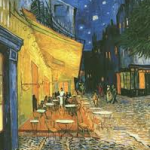By Gennaios Likourgiotis (A class)
Starry nights and sunflowers, self-portraits and café settings-all painted in bold, intense colors. Today, people around the world immediately recognize these as the work of Vincent Van Gogh, the Dutch painter. Probably no other artist, at any time in any culture, has achieved such popularity. But who was this man exactly, and why, even today, do his art and life have such power to move us?
An artist is born
Vincent van Gogh was born on March 30, 1853, in a small village, in southern Holland. As a child he was serious and sensitive. He loved to draw, and his work showed talent, but no one encouraged him to become an artist. Instead, his father thought he should take a sensible job-something like a carpenter. As a young adult, he wandered from job to job with little success and very little money, becoming more depressed with each failure.
In March 1880, however, just before his 27th birthday, something changed inside van Gogh. He realized he was meant to be a painter, and he began to study art, receiving a subsidy from his brother Theo, which helped him to live.
Discovering color
In 1886, van Gogh moved from Holland to Paris, hoping to learn more about color techniques being used by Impressionist artists there. Instead of greys and browns, his work began to emphasize blue and red, and then yellow and orange. Soon he began to see life differently: Go slow. Stop thinking. Look around. You’ll see something beautiful if you open yourself. These were the principles that guided his art. With his innovative color combinations, van Gogh wanted to show his viewers how to better appreciate a flower, the night sky, or a person’s face.
Descent into madness
Few who lived in van Gogh’s time appreciated his work, however. Many laughed when they saw his paintings, which hurt the sensitive artist terribly. In February 1888 he moved away from Paris to Arles, a town in southern France. Often he could not eat or sleep, and stayed up into the early morning hours painting.
Days passed, and he spoke to no one. Following an argument with his fellow artist Paul Gauguin, van Gogh took a razor and cut off his own earlobe. He never explained why, but by now, many were convinced that van Gogh was crazy, and indeed, his mental health started to decline. He began to have attacks during which he would hear strange sounds and think people were trying to hurt him. In the spring of 1889, he was sent to a mental hospital in St. Remy, a town near Arles.
What exactly was van Gogh suffering from? No one knows for sure, but some now think it may have been a form of manic depression. Whatever his condition, van Gogh’s illness both inhibited and inspired his creativity. When his attacks came, he could not paint. But during his periods of calm, he was able to complete more than a hundred masterpieces, including the classic The Starry Night. “Working on my pictures”, he wrote, “is almost a necessity for my recovery.”
The Starry Night
Final Days
Following his release from hospital in May 1890, van Gogh took a room in a town just north of Paris. For the 70 days that he lived there, he produced, on average, a painting a day. Until his death, however, he was unable to sell a single one; today those paintings would be worth more than a billion U.S. dollars.
It was at this time that van Gogh either borrowed or stole a gun. On the afternoon of July 27, 1890, he went out to the country and shot himself in the stomach. Two days later, Vincent van Gogh died at the age of 37.
What caused him to take his own life- his lack of financial success, mental illness, his loneliness? The question, like so many others in van Gogh’s life, remains unanswered.
Van Gogh’s Legacy
Over a century after his death, van Gogh still remains extremely popular. His story-of a man who resisted materialism, who was alone and unappreciated-gives people something they need. We find pieces of ourselves in him. This may also explain the insanely high prices paid for van Gogh’s work. His Portrait of Dr. Gachet was sold in 1990 for more than $80 million to a Japanese businessman, breaking the world for art pieces. Many of his other works have also been sold for millions. Of course, people are buying great art when they purchase one of van Gogh’s paintings. But they are also buying a piece of history, which, like his work, will live on forever.
Portrait of Dr. Gachet
By Gennaios Likourgiotis (A class)
Starry nights and sunflowers, self-portraits and café settings-all painted in bold, intense colors. Today, people around the world immediately recognize these as the work of Vincent Van Gogh, the Dutch painter. Probably no other artist, at any time in any culture, has achieved such popularity. But who was this man exactly, and why, even today, do his art and life have such power to move us?
An artist is born
Vincent van Gogh was born on March 30, 1853, in a small village, in southern Holland. As a child he was serious and sensitive. He loved to draw, and his work showed talent, but no one encouraged him to become an artist. Instead, his father thought he should take a sensible job-something like a carpenter. As a young adult, he wandered from job to job with little success and very little money, becoming more depressed with each failure.
In March 1880, however, just before his 27th birthday, something changed inside van Gogh. He realized he was meant to be a painter, and he began to study art, receiving a subsidy from his brother Theo, which helped him to live.
Discovering color
In 1886, van Gogh moved from Holland to Paris, hoping to learn more about color techniques being used by Impressionist artists there. Instead of greys and browns, his work began to emphasize blue and red, and then yellow and orange. Soon he began to see life differently: Go slow. Stop thinking. Look around. You’ll see something beautiful if you open yourself. These were the principles that guided his art. With his innovative color combinations, van Gogh wanted to show his viewers how to better appreciate a flower, the night sky, or a person’s face.
Descent into madness
Few who lived in van Gogh’s time appreciated his work, however. Many laughed when they saw his paintings, which hurt the sensitive artist terribly. In February 1888 he moved away from Paris to Arles, a town in southern France. Often he could not eat or sleep, and stayed up into the early morning hours painting.
Days passed, and he spoke to no one. Following an argument with his fellow artist Paul Gauguin, van Gogh took a razor and cut off his own earlobe. He never explained why, but by now, many were convinced that van Gogh was crazy, and indeed, his mental health started to decline. He began to have attacks during which he would hear strange sounds and think people were trying to hurt him. In the spring of 1889, he was sent to a mental hospital in St. Remy, a town near Arles.
What exactly was van Gogh suffering from? No one knows for sure, but some now think it may have been a form of manic depression. Whatever his condition, van Gogh’s illness both inhibited and inspired his creativity. When his attacks came, he could not paint. But during his periods of calm, he was able to complete more than a hundred masterpieces, including the classic The Starry Night. “Working on my pictures”, he wrote, “is almost a necessity for my recovery.”
Final Days
Following his release from hospital in May 1890, van Gogh took a room in a town just north of Paris. For the 70 days that he lived there, he produced, on average, a painting a day. Until his death, however, he was unable to sell a single one; today those paintings would be worth more than a billion U.S. dollars.
It was at this time that van Gogh either borrowed or stole a gun. On the afternoon of July 27, 1890, he went out to the country and shot himself in the stomach. Two days later, Vincent van Gogh died at the age of 37.
What caused him to take his own life- his lack of financial success, mental illness, his loneliness? The question, like so many others in van Gogh’s life, remains unanswered.
Van Gogh’s Legacy
Over a century after his death, van Gogh still remains extremely popular. His story-of a man who resisted materialism, who was alone and unappreciated-gives people something they need. We find pieces of ourselves in him. This may also explain the insanely high prices paid for van Gogh’s work. His Portrait of Dr. Gachet was sold in 1990 for more than $80 million to a Japanese businessman, breaking the world for art pieces. Many of his other works have also been sold for millions. Of course, people are buying great art when they purchase one of van Gogh’s paintings. But they are also buying a piece of history, which, like his work, will live on forever.







